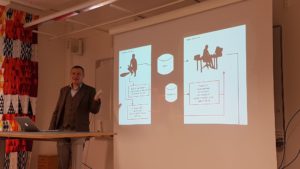To grow and to be able to reach those levels we did not think was possible, every one of us need role models. They help us raise our ambitions and show us what is possible to achieve. It goes for all parts of life, but is perhaps especially relevant when you are a student or a researcher.
That is one of the reasons why we like to give some extra attention to researchers at the Department of ALM when they are granted funding for new projects or in other ways show us what is possible.

Earlier this week, Isto Huvila (professor at the Department of ALM) presented his coming research project CAPTURE. A catchy name to help you remember the full title; CApturing Paradata for documenTing data creation and Use for the REsearch of the future. It addresses the problem of how to know what information about the making and earlier use of research data that is important to preserve in order to make this data usable in the future. Although an important issue for any research field, scholars in the digital humanities are often using digital methods that creates data that can be especially difficult to reuse because of non-compatible formats or badly designed algorithms.
I personally cannot stop myself from imagining how a better solution of “conserving” research data could help save resources that can be used more effectively. Research data, even in its “raw” state before it has undergone any polishing or analysis, is often the result of much effort and invested money. That is why it is so important to try to find solutions on how data can be recycled or at least used in some way, also beyond its direct purpose. I guess that is one of the reasons why the European Research Council valued the project and decided to fund it. When it starts, it will be one of the biggest research projects at the Department of ALM, and we are all excited to follow its progress. Experiences and results from the project are in time also going to make its way into the education given to our programme students, offering them fresh insights into on-going state-of-the-art research.
After the presentation of CAPTURE it was time for the most important thing; the celebration cake! As some of you might remember from earlier blog entries, I have a weakness for using cakes as metaphors; in this case, when reflecting on how projects like this offer sweet experiences for the whole department, including researchers as well as students.
